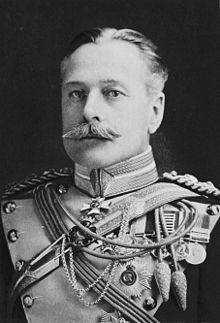
Back دوغلاس هيج (إيرل هيج الأول) Arabic دوجلاس هيج ايرل هيج الاول ARZ Дуглас Хейг Byelorussian Дуглас Гэйг BE-X-OLD Дъглас Хейг Bulgarian Douglas Haig Catalan Douglas Haig Czech Douglas Haig Welsh Douglas Haig Danish Douglas Haig, 1. Earl Haig German
This article may be too long to read and navigate comfortably. (December 2023) |
The Earl Haig | |
|---|---|
 Haig in 1917 | |
| Born | 19 June 1861 Charlotte Square, Edinburgh, Scotland |
| Died | 29 January 1928 (aged 66) 21 Prince's Gate, London, England |
| Allegiance | United Kingdom |
| Service/ | British Army |
| Years of service | 1884–1920 |
| Rank | Field Marshal |
| Commands held | British Expeditionary Force (1915–19) First Army (1914–15) I Corps (1914) Aldershot Command (1912–14) Chief of the General Staff in India (1909–12) 17th Lancers (1901–03) 3rd Cavalry Brigade (1900) |
| Battles/wars | Mahdist War Second Boer War First World War |
| Awards | Knight of the Order of the Thistle Knight Grand Cross of the Order of the Bath Member of the Order of Merit Knight Grand Cross of the Royal Victorian Order Knight Commander of the Order of the Indian Empire Mentioned in Despatches Complete list |
Field Marshal Douglas Haig, 1st Earl Haig, KT, GCB, OM, GCVO, KCIE (/heɪɡ/; 19 June 1861 – 29 January 1928) was a senior officer of the British Army. During the First World War he commanded the British Expeditionary Force (BEF) on the Western Front from late 1915 until the end of the war. He was commander during the Battle of the Somme, the Battle of Arras, the Third Battle of Ypres, the German Spring Offensive, and the Hundred Days Offensive.[1][2][3]
His military career included service in the War Office, where he was instrumental in the creation of the Territorial Force in 1908. In January 1917 he was promoted to the rank of Field Marshal, subsequently leading the BEF during the final Hundred Days Offensive, when it crossed the Canal du Nord and broke through the Hindenburg line, capturing 188,700 German prisoners. This campaign, in combination with the Kiel mutiny, the Wilhelmshaven mutiny, the proclamation of a republic on 9 November 1918 and civil unrest across Germany, led to the armistice of 11 November 1918. It is considered by some historians to be one of the greatest victories ever achieved by a British-led army.[1][2][3]
He gained a favourable reputation during the immediate post-war years, with his funeral becoming a day of national mourning. However he also had some prominent contemporary detractors and, beginning in the 1960s, has been widely criticised for his wartime leadership.[4][5][6] He was nicknamed "Butcher Haig" for the two million British casualties endured under his command.[4] The Canadian War Museum comments: "His epic but costly offensives at the Somme (1916) and Passchendaele (1917) have become nearly synonymous with the carnage and futility of First World War battles."[7]
Major-General John Davidson, one of Haig's biographers, praised Haig's leadership, and since the 1980s many historians have argued that the public hatred of Haig failed to recognise the adoption of new tactics and technologies by forces under his command, the important role played by British forces in the allied victory of 1918, and that high casualties were a consequence of the tactical and strategic realities of the time.[1][2][3][8][9][10]
- ^ a b c Sheffield 2002, p. 21.
- ^ a b c Sheffield 2002, p. 263.
- ^ a b c Hart 2008, p. 2.
- ^ a b "Field Marshal Douglas Haig would have let Germany win, biography says". The Times. 10 November 2008. Retrieved 2 August 2022.
- ^ J. P. Harris, Douglas Haig and the First World War (2009), p. 545
- ^ Norman, Geoffrey (11 May 2007). "Field Marshal Sir Douglas Haig: World War I's Worst General". Historynet. Military History Magazine. Retrieved 2 August 2022.
- ^ See "Canada and the First World War: Sir Douglas Haig"
- ^ Davidson 2010, p. 137.
- ^ Todman 2005, pp. 73–120.
- ^ Corrigan 2002, pp. 298–330, 406–410.
© MMXXIII Rich X Search. We shall prevail. All rights reserved. Rich X Search